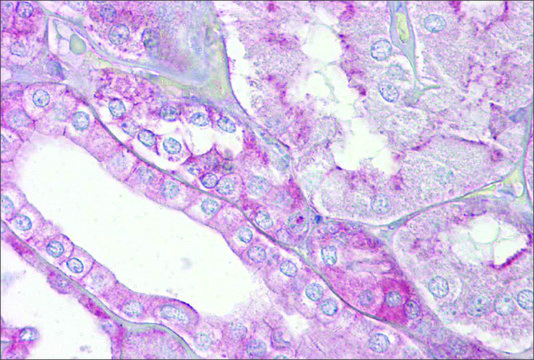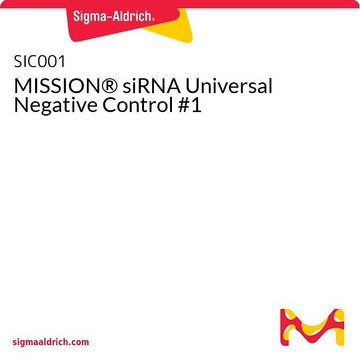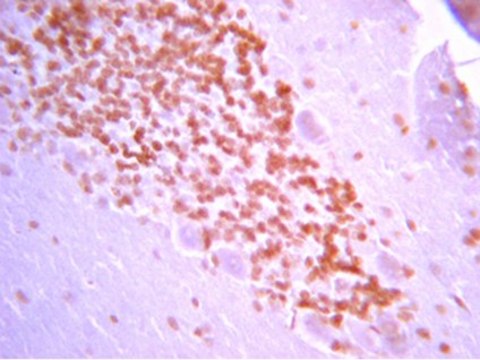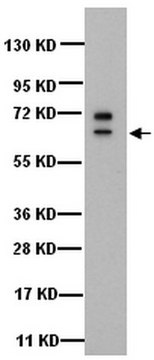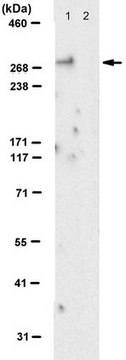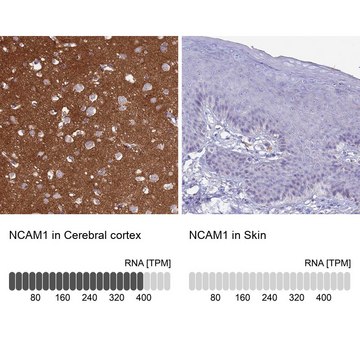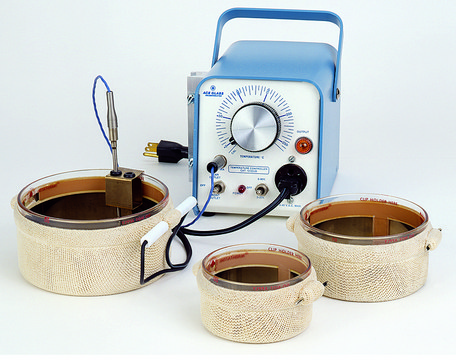General description
Spectrin alpha chain, non-erythrocytic 1 (UniProt: Q13813; also known as Alpha-II spectrin, Fodrin alpha chain, Spectrin, non-erythroid alpha subunit) is encoded by the SPTAN1 (also known as NEAS, SPTA2) gene (Gene ID: 6709) in human. Non-erythroid Spectrin plays a role in stabilizing membrane structures, maintaining cell shape and linking the cytoskeleton to plasma membranes or intracellular vesicles. Alpha II-spectrin is a structural protein abundant in neurons of the central nervous system and is cleaved into signature fragments by proteases involved in necrotic and apoptotic cell death. It is one of the primary targets cleaved by activated caspases during apoptosis. The full-length protein can be cleaved to yield an N-terminal product of ~150 kDa, and C-terminal products of ~120 and ~35 kDa. Alpha II- spectrin is involved in secretion, interacts with calmodulin in a calcium-dependent manner and is thus candidate for the calcium-dependent movement of the cytoskeleton at the membrane. It has two calcium-binding regions (aa 2336-2347 and 2379-2390). Its mu-calpain cleavage site is localized at Tyr-Gly (aa 1176-1177). Phosphorylation of Tyrosine 1176 is shown to reduce sensitivity to cleavage by calpain in vitro. Plasma levels of calpain-cleaved Alpha II-Spectrin, N-terminal fragment (SNTF) serve as a useful marker for mild to severe traumatic brain injury and SNTF immunostaining can also reveal previously undetected traumatic brain injury. Mutations in SPTAN1 gene are known to cause early infantile epileptic encephalopathy that is characterized by seizures associated with hypsarrhythmia, profound mental retardation with lack of visual attention and speech development. (Ref.: Siman, R., et al. (2013). Front. Neurol. 4; Article 190; Johnson VE., et al (2016). Acta Neuropathol. 131(1); 115-135).
Specificity
This rabbit polyclonal antibody specifically detects calpain-generated neoepitope in SNTF. It targets a neoepitope of 6 amino acids at the carboxyl-end of the stable calpain-derived alpha-spectrin.
Immunogen
Epitope: unknown
KLH-conjugated linear peptide corresponding to calpain-generated neoepitope in SNTF (CAQQEVY).
Application
Anti-SNTF (cleaved spectrin), Cat. No. ABN2264, is a highly specific rabbit polyclonal antibody that targets cleaved Spectrin alpha chain, non-erythrocytic 1 and has been tested for use in ELISA, Immunohistochemistry, and Western Blotting.
Immunohistochemistry Analysis: A representative lot detected SNTF (cleaved spectrin) in swine and human brain sections (Johnson, V.E., et. al. (2016). Acta Neuropathol. 131(1):115-35).
Western Blotting Analysis: A representative lot detected SNTF (cleaved spectrin) in Western Blotting applications (Roberts-Lewis, J.M., et. al. (1994). J Neurosci. 14(6):3934-44).
Enzyme Immunoassay Analysis (ELISA): A representative lot detected SNTF (cleaved spectrin) in detection antibody for human serum samples (Siman, R., et. al. (2013). Front Neurol. 4:190).
Research Category
Neuroscience
Quality
Evaluated by Western Blotting in mouse brain extract incubated with calcium chloride to activate calpain.
Western Blotting Analysis: A 1:10,000 dilution of this antibody detected Spectrin alpha chain, non-erythrocytic 1 in Mouse Brain extract incubated with calcium chloride to activate Calpain.
Target description
~160 kDa observed. Calculated molecular weight of full length protein is 284.54 kDa Uncharacterized bands may be observed in some lysate(s).
Physical form
Rabbit polyclonal antiserum with 0.05% sodium azide.
Unpurified
Storage and Stability
Stable for 1 year at -20°C from date of receipt. Handling Recommendations: Upon receipt and prior to removing the cap, centrifuge the vial and gently mix the solution. Aliquot into microcentrifuge tubes and store at -20°C. Avoid repeated freeze/thaw cycles, which may damage IgG and affect product performance.
Other Notes
Concentration: Please refer to lot specific datasheet.
Disclaimer
Unless otherwise stated in our catalog or other company documentation accompanying the product(s), our products are intended for research use only and are not to be used for any other purpose, which includes but is not limited to, unauthorized commercial uses, in vitro diagnostic uses, ex vivo or in vivo therapeutic uses or any type of consumption or application to humans or animals.

